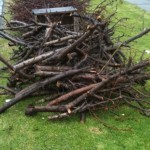Firewood
Wood can be the Most Expensive………..or the Cheapest heating available for your new home.
It all depends on your level of commitment.
Most Expensive
Buy firewood at the service station and burn it in an open fire and it could easily cost $20-$30 for a few hours in the evening.
Cheapest
Use a slow combustion wood heater, collect and split your own wood, and it can be less than $10 for a week of continuous heat.
How Much Wood Do You Need?
From my experience of heating a 180sqm home I reckon about ten 6×4 trailer loads (around 10 cubic m) is enough for a typical winter.
Another way of looking at it is what a friend of mine says “All you need to heat a house is to pick up three logs every day of the year”. I would say that’s about right.
Low Cost Sources
- Nature Strips, Free, I often see piles of branches outside suburban homes. Here is around three night of heat recently seen on a Nature Strip! Be careful some councils don’t approve of removing stuff left for council collection.
- Friends, Free If you make it known you are willing to collect wood you can quite often get asked by friends take aware tree branches. WARNING Don’t offer to cut down trees, that should only be done by licenced, and insured, tree fellers
- State Forests and Public Land, Free – $25/trailer. Each state has their rules in Victoria its free but only at certain times of the year. In NSW it ranges from $8-$25 per cubic m.
- Timber Companies, Free I often see skips of free firewood outside factories but be careful that you only pick up untreated wood. The fumes from burning treated wood can be extremely toxic.
See why Wood Heaters are Better than Open Fires
Wood-burning appliances and fireplaces may emit large quantities of air pollutants. Wood smoke contains hundreds of chemical compounds including nitrogen oxides, carbon monoxide, organic gases, and particulate matter, many of which have adverse health effects. In many urban and rural areas, smoke from wood burning is a major contributor to air pollution. Because of this, some municipalities restrict wood heating appliance use when the local air quality reaches unacceptable levels. Others restrict or ban the installation of wood-burning appliances in new construction. Before installing a wood-burning system, you should contact your local building codes department, state energy office, or state environmental agency about wood-burning regulations that may apply in your area.
While some users give wood heating a bad name, there are hundreds of thousands of responsible homeowners who burn wood well. By that we mean their firewood is harvested sustainably, it is burned cleanly and efficiently, and its energy is used to reduce the net greenhouse gas emissions responsible for global warming. Here, you will find support for your efforts to use wood well. We’ll also clear up some misconceptions about wood heating – there are a lot of them around. At woodheat.org, you’ll get a balanced view of the merits of wood heating.